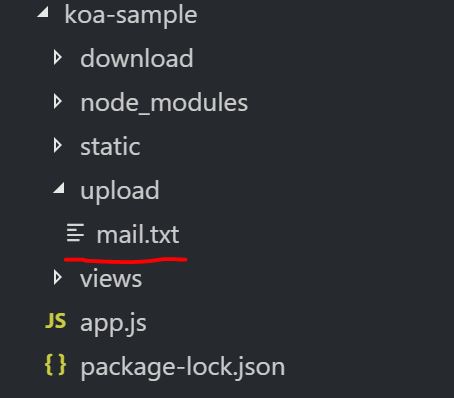4.2 文件上传/下载
下载
在上一节基础上我们来看看如何下载文件。我们先在根目录下,新增一个 download 目录,并且放入一个 text.txt,然后更改 index.js 和 app.js 试验一下。
// index.js
document.getElementById('btn').onclick = () => {
window.open('/download/text.txt', '_blank');
};
// app.js
const koa = require('koa');
const router = require('koa-router')();
const static = require('koa-static');
const path = require('path');
const nunjucks = require('nunjucks');
const send = require('koa-send');
const app = new koa();
let env = nunjucks.configure('views'); // path to model file folder
router.get('/', (ctx, next) => {
ctx.response.body = env.render('index.html', {
title: 'Index'
});
});
router.get('/download/:filename', async (ctx, next) => {
let filename = ctx.params.filename;
let filePath = `./download/${filename}`; // download file folder relative to app.js
ctx.attachment(filePath); // mime type, active the download window in browser
await send(ctx, filePath);
});
app.use(router.routes());
app.use(static(path.join( __dirname, './static')));
app.listen(3000, () => {
console.log('Koa running at port 3000...');
});
弹窗下载成功~

上传
现在我们可以从服务器下载文件了,那么,我们要如何上传呢?我们需要之前在 POST data 使用过的 koa-body 来帮忙,因为 koa 并不解析 post 的数据,而 koa-body 帮我们处理好了各种 post 情况。然后,我们新增一个处理上传文件的路由,来处理上传的文件。
// app.js
const koa = require('koa');
const router = require('koa-router')();
const static = require('koa-static');
const send = require('koa-send');
const body = require('koa-body');
const nunjucks = require('nunjucks');
const fs = require('fs');
const path = require('path');
const app = new koa();
let env = nunjucks.configure('views'); // path to model file folder
app.use(body({ // options to handle the post file
multipart: true,
formidable: {
maxFileSize: 200*1024*1024 // the max size of uploading file
}
}));
router.get('/', (ctx, next) => { // index router
ctx.response.body = env.render('index.html', {
title: 'Index'
});
});
/**
* Save the upload file
* @param {file} file: the file to be saved
*/
function saveFile(file) {
const reader = fs.createReadStream(file.path);
let filePath = path.join(__dirname, 'upload/') + `/${file.name}`;
const upStream = fs.createWriteStream(filePath);
reader.pipe(upStream);
}
router.post('/upload', async (ctx, next) => { // handle the upload files
console.log(ctx.request.files);
const files = ctx.request.files.file; // file: id of the input
if (files.length > 1) { // list of files
for (let file of files) {
saveFile(file);
}
} else if (files) { // single file
saveFile(files);
}
ctx.body = 'Upload successfully.';
});
app.use(router.routes());
app.use(static(path.join( __dirname, './static')));
app.listen(3000, () => {
console.log('Koa running at port 3000...');
});
页面上增加一下上传文件的按钮:
<!DOCTYPE html>
<html lang="en">
<head>
<meta charset="UTF-8">
<meta name="viewport" content="width=device-width, initial-scale=1.0">
<meta http-equiv="X-UA-Compatible" content="ie=edge">
<title>{{ title }}</title>
</head>
<body>
<h1>{{ title }}</h1>
<form action="http://localhost:3000/upload" method="post" enctype="multipart/form-data">
<input id="file" type="file" name="file" value="" multiple="multiple" />
<button id="upload" type="submit">Upload</button>
</form>
<button id="btn">Click me!</button>
</body>
<link rel="stylesheet" type="text/css" href="css/index.css">
<script src="js/index.js"></script>
</html>
好了,我们来试验一下:


上传文件是个很敏感的操作,因为很可能会带有恶意文件,所以存储文件的函数需要自己定制化